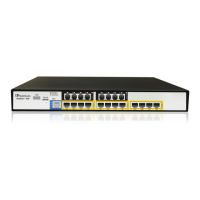51.3 Automatic Configuration Methods
This section describes available methods that can be used for automatic device
configuration.
51.3.1 DHCP-based Configuration Server
The DHCP server can be configured to automatically provide each device with a temporary
IP address so that individual MAC addresses are not required. Configuration occurs at a
staging warehouse for this method.
Below is an example configuration file for Linux DHCP server (dhcpd.conf). The devices
are allocated temporary IP addresses in the range 10.31.4.53 to 10.31.4.75. TFTP is
assumed to be on the same computer as the DHCP server (alternatively, the "next-server"
directive may be used).
ddns-update-style ad-hoc;
default-lease-time 60;
max-lease-time 60;
class "gateways" {
match if(substring(hardware, 1, 3) = 00:90:8f);
}
subnet 10.31.0.0 netmask 255.255.0.0 {
pool {
allow members of "audiocodes";
range 10.31.4.53 10.31.4.75;
filename "SIP_F6.60A.217.003.cmp –fb;device.ini";
option routers 10.31.0.1;
option subnet-mask 255.255.0.0;
}
}
51.3.2 HTTP-based Automatic Updates
An HTTP/S server can be placed in the customer's network where configuration and
software updates are available for download. This does not require additional servers at
the customer premises and is NAT-safe.
For example, assume the core network HTTPS server is https://www.corp.com. A master
configuration ini file should be placed on the server, e.g.,
https://www.corp.com/gateways/master.ini. This file could point to additional ini files,
auxiliary files (e.g., call progress tones), and software files (cmp), all on the same HTTP
server or different HTTP servers in the network.
The main advantage of this method is that the HTTP configuration can be checked
periodically when the device is deployed at the customer site. HTTP(S) is not sensitive to
NAT devices, enabling configuration whenever needed without on-site intervention.
For additional security, the URL may contain a different port, and username and password.
The devices should only be pre-configured with the URL of the initial ini file, using one of
the following methods:

